Intel SSD 760p Review: The New NVMe Value Leader
Why you can trust Tom's Hardware
512GB Class Performance
Comparison Products
Many of the products in our tests will cease to exist in the coming months. Toshiba, Western Digital, Intel, Micron, and Samsung all have new 64-layer flash. The older planar and 32-layer production has stopped except for guaranteed availability contract work.
The Corsair Neutron NX500, Intel 600p, MyDigitalSSD BPX, Toshiba RD400, Samsung 960 Pro, and Western Digital Black PCIe all fall into the outgoing category. The Plextor M9Pe and Samsung PM981 join the 760p with new 64-layer flash. The Samsung PM981 is an OEM drive currently shipping in new notebooks at a premium price point. The drive gives you some insight into what you should expect when you spend upwards of $400 for a 512GB OEM NVMe upgrade.
The Samsung 960 Pro is almost a novelty. It's one of the most expensive NAND-based SSDs on the market, but it shows us what's possible with our test systems. We can point to the drive as the performance leader in many of the tests, but it also costs much more than the other products.
Sequential Read Performance
To read about our storage tests in-depth, please check out How We Test HDDs And SSDs. We cover four-corner testing on page six of our How We Test guide.
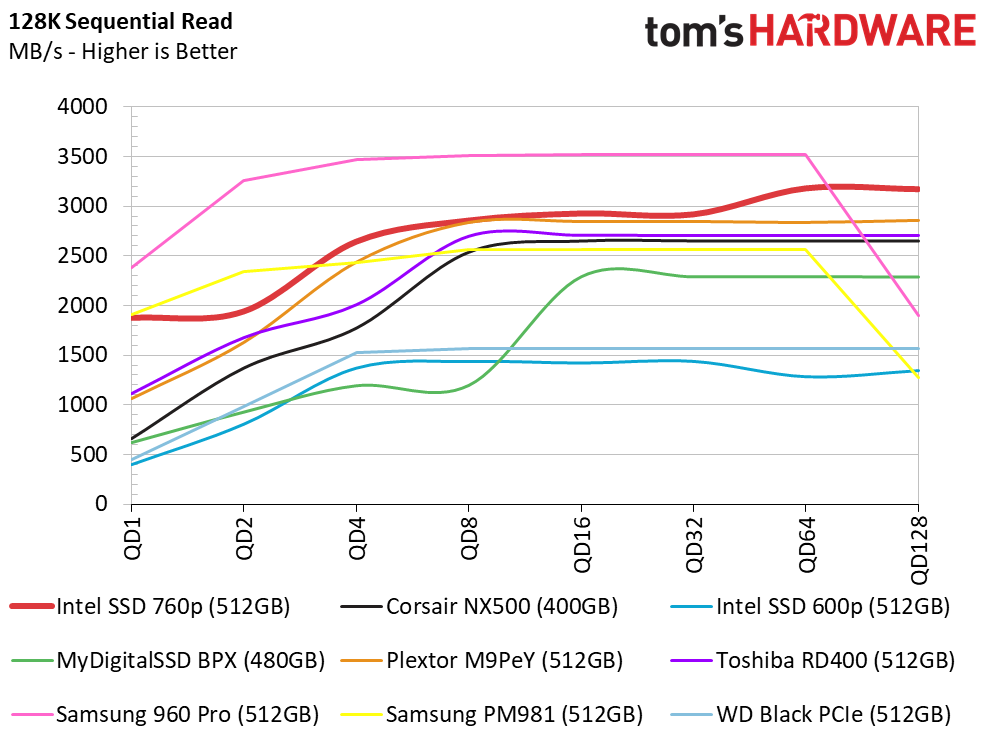

We immediately noticed the increased performance at low queue depths (QD) with SMI's new SM226x controllers. Intel matches the Samsung PM981 OEM SSD at QD1, but it doesn't make it to the same level as the 960 Pro (with MLC flash).
The 760p beats the MyDigitalSSD BPX (our current go-to NVMe SSD recommendation) by more than 1,000 MB/s. The improvement over the 600p is even more impressive. Intel's 760p also leaped over several very good NVMe SSDs at low queue depths.
The drive also delivers impressively high throughput when you read several sequential files simultaneously.
Get Tom's Hardware's best news and in-depth reviews, straight to your inbox.
Sequential Write Performance
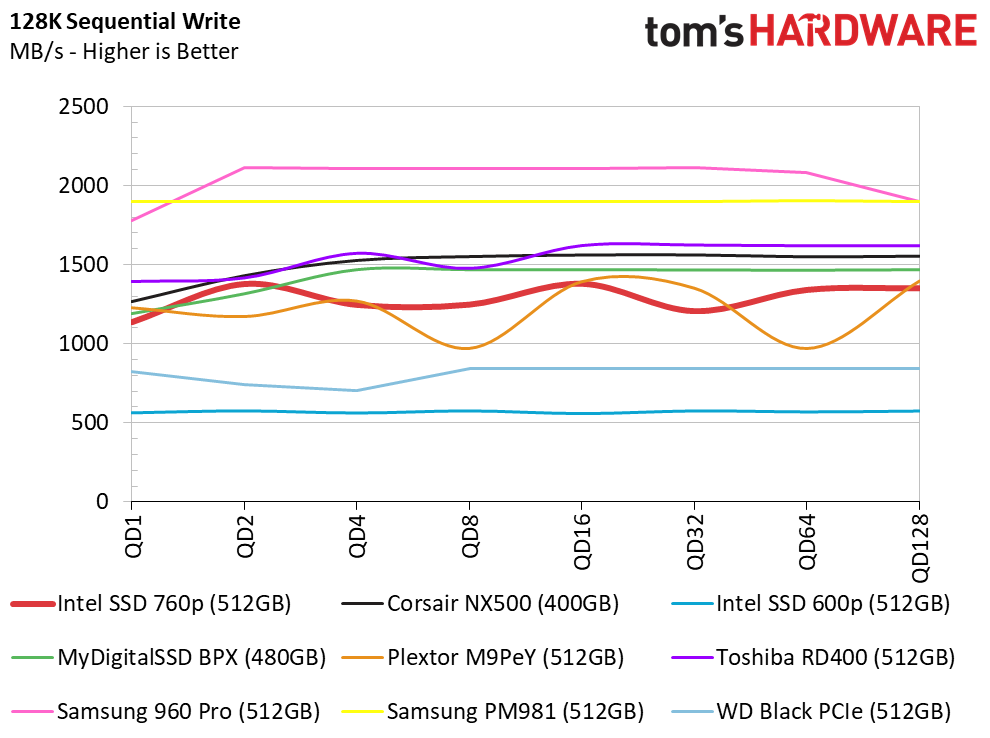

Sequential write performance is consistent across the queue depth range during our new burst testing. The 760p is nearly three times faster than the outgoing 600p and twice as fast as the Western Digital Black PCIe. We measured nearly 1,400 MB/s at QD2, which is representative of performance you'll see with smaller files.
Sustained Sequential Write Performance
Larger file transfers are much slower. The 760p 512GB writes 128KB data at ~550 MB/s after you saturate the SLC cache. The smaller 760p models will be slower in this workload, and there isn't a guarantee that the larger drives will be faster. This is still a very acceptable result even if you transfer files over a 10-gigabit network or from a high-speed Thunderbolt 3 device.
Random Read Performance



The Intel SSD 760p doesn't look like a stellar SSD if you only focus on the line graph. You have to look at the low queue depth bar chart to spot the 760p's very aggressive performance at the all-important QD1.
Random Write Performance

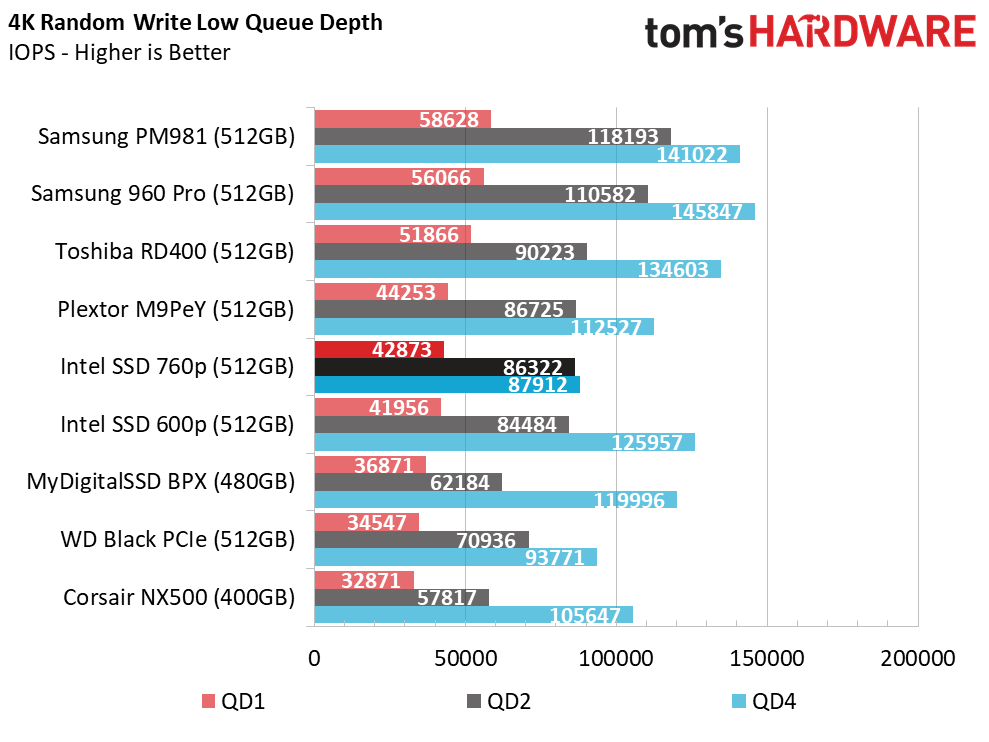

We see the same type of result in the 4KB random write test. The 760p's peak performance isn't very special. In fact, the drive doesn't speed up much after QD2. The 760p's performance at QD1 is only slightly better than the previous generation, but it's much faster than most other entry-level NVMe SSDs.
70% Mixed Sequential Workload
We describe our mixed workload testing in detail here and describe our steady state tests here.
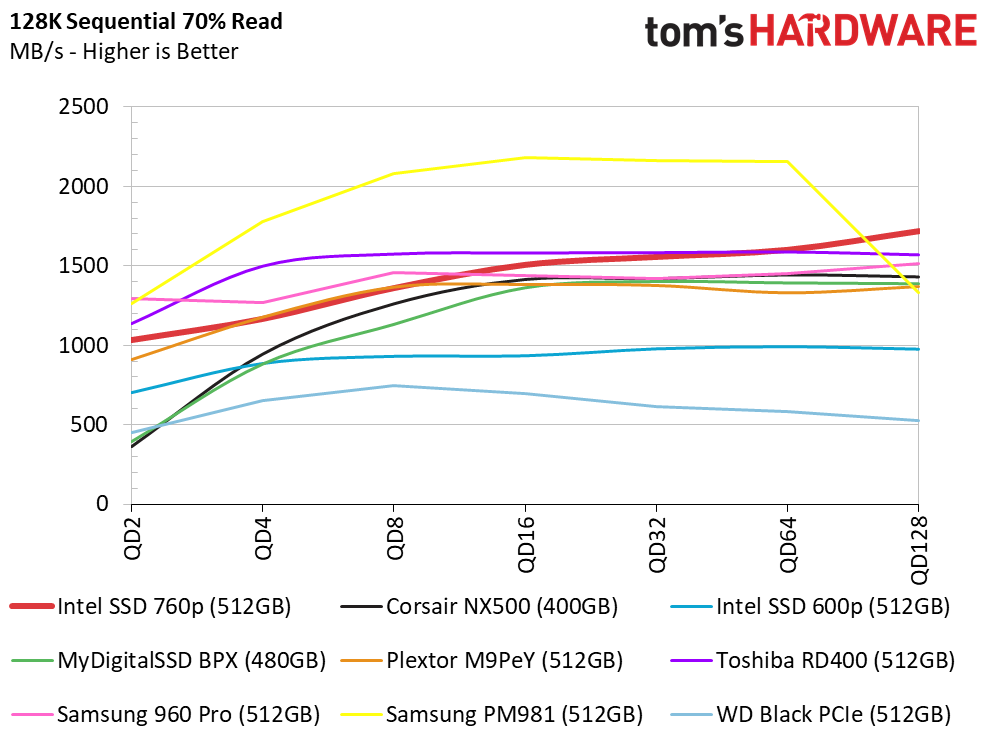

The 760p improves upon the 600p's QD2 mixed sequential performance by nearly 300 MB/s. Intel's new 64-layer NAND is much better for mixed workloads than the first-gen 32-layer.
70% Mixed Random Workload


The performance improvement carries over to our mixed random workloads. The 760p only trails the Samsung drives. These results should be representative of real application performance in your desktop or notebook PC.
Sequential Steady-State

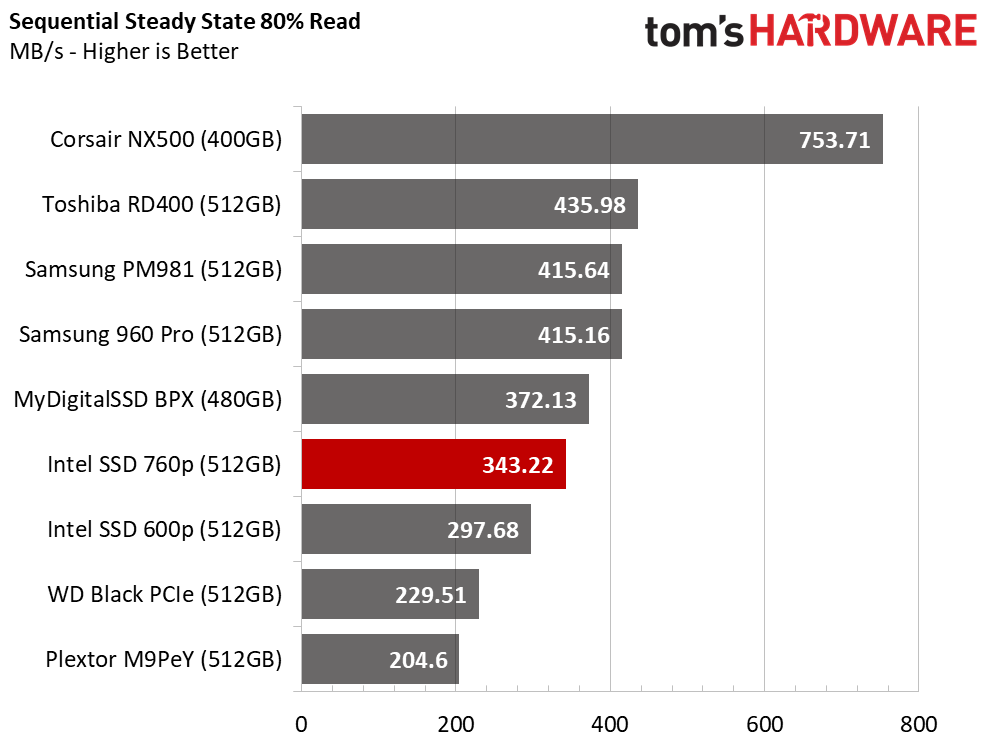

The 760p is a pure consumer SSD, and the pricing reflects that. Some users may want to run the drive in a workstation environment, but we don't recommend even light professional applications due to the relatively low endurance rating.
Random Steady-State

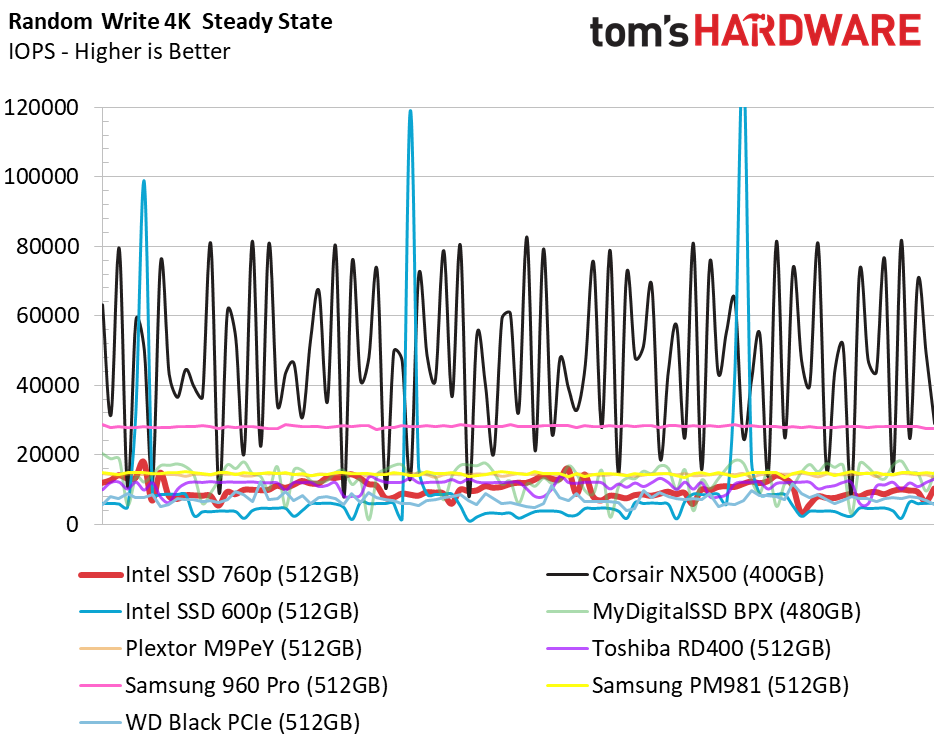
We measured a noticeable improvement in both performance consistency and average performance in a worst-case environment. The new SMI controller no longer suffers the massive performance spikes that come from SLC buffer flushing. We would recommend the 760p to users looking to build a RAID array. This series should also work with Intel's vROC feature on X299 motherboards.
PCMark 8 Real-World Software Performance
For details on our real-world software performance testing, please click here.




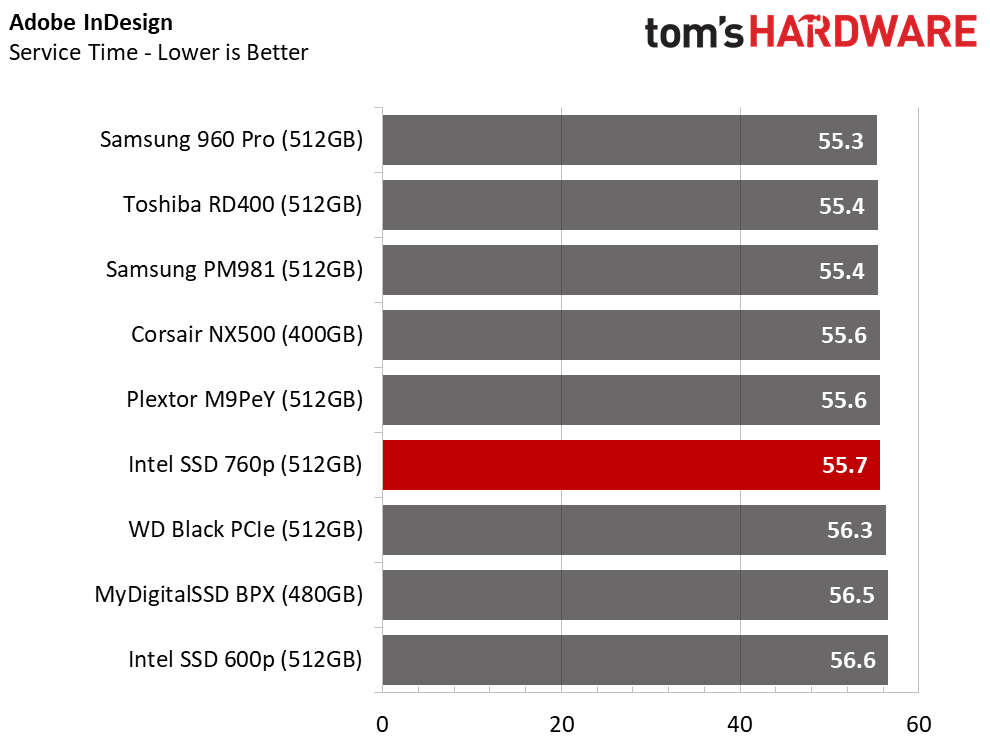





Despite all the improvements, we only measured a moderate gain in application performance over the previous-gen 600p. It's very difficult to make large gains here because the operating system is still highly optimized for HDDs.
Application Storage Bandwidth
The 760p falls to the lower end of the mainstream SSD performance ladder, but it's an improvement over the 600p. This is where pricing evens the field a bit.
PCMark 8 Advanced Workload Performance
To learn how we test advanced workload performance, please click here.



The 512GB 760p recovers quickly after a session of heavy data writes. Not every SSD makes the transition as quickly as this drive. The Plextor M9Pe is a good example—it needs more than five minutes to process background activity and perform cleanup operations.
Total Service Time

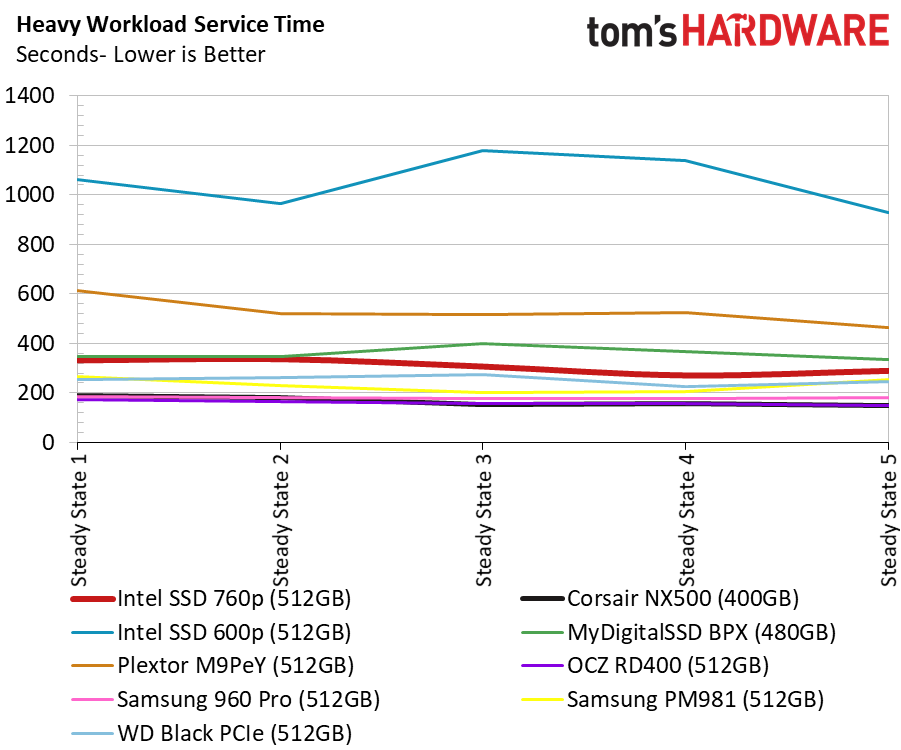

The 760p recovers just as well as the other mainstream products. After the recovery, the drive completes the workload nearly twice as fast as the 600p. The 600p and 760p have the same price, so we consider this a victory for Intel. The company hasn't generated a lot of positive news for its flash recently, so it's nice to see them back on track.
Disk Busy Time
The service time tests measure how long it took the system to complete the tasks, but the disk busy time results show how long the drives were actually active. It's easy to see how much the 64-layer Intel NAND improves on the 600p's older 32-layer. The new model can run heavier workloads without falling on its face. The 600p produced a poor user experience during heavy workloads, but the new drive corrects those issues.
BAPCo SYSmark 2014 SE Responsiveness Test


We were able to add more consumer NVMe SSDs in these tests. There are more products available than ever before as we transition away from planar and 32-layer 3D technology (48-layer for Samsung). The older models will eventually sell out, leaving the new drives to battle for your hard-earned dollars.
The system responsiveness test runs in our Lenovo Y700-17 gaming notebook under AC power. We measure power at the system level, but we're focused on the responsiveness score. The older 600p delivers a better result than the 760p, which is odd.
BAPCo MobileMark 2012.5 Notebook Battery Life
To learn how we test advanced workload performance, please click here.


The 512GB 760p performed very well when our Lenovo Y700-17 gaming notebook was on battery power. Lenovo didn't design this notebook with long battery life in mind, but an SSD gives you more usable battery time than the pre-installed hard disk drive. The 760p would have performed very well in our recent SSD battery life roundup. It's one of the few drives capable of delivering long battery life and high performance when the PCIe bus is running at a reduced rate.
MORE: Best SSDs
MORE: How We Test HDDs And SSDs
MORE: All SSD Content
Current page: 512GB Class Performance
Prev Page Features & Specifications Next Page 256GB And 128GB Class Performance
Chris Ramseyer was a senior contributing editor for Tom's Hardware. He tested and reviewed consumer storage.
-
AgentLozen I'm really impressed with the 760p. It isn't a performance king but for what it can do, it has an amazing price point. Intel made good on it's promise of 2x the performance of the 600p.Reply
$200 for a 512GB NVMe SSD is a good price, but it's still expensive compared to similarly sized SATA drives. Do you suppose NVMe drives will fall enough in the next year to make them competitive with SATA pricing? -
mcconkeymike I own the 600p in a laptop, while it isn't bad, I can see its shortcomings. I hope that once this 760p launches and gets a firmware update that it will be as good as we hope. With that price, I'm sure I'll be eyeballing it hard.Reply -
nooneymous I find it funny that all of these measurements are used to compare ssds, but when it comes to the "real world" there's little difference in perf. PCmark8 shows almost no sensitivity for all the goodness. Does that mean just by the cheapest SSD with a reasonable warranty?Reply -
237841209 Meltdown affects processors, not SSDs. They wouldn't include a whole updated copy of Windows 10 if that's what you're implying.Reply -
Co BIY 1. Also looking forward to the review of the new MyDigitalSSD. I have been pleased with my BPX.Reply
2. Imagine if Intel stirred in a little Xpoint cache into the drives. We know they have the algorithms. I am a lot out of my depth but would the Xpoint work well for the "Datamap/Addressing list" that seems to be a major bottle neck for the newer drives. Seems like a place for synergy.
3. When is Microsoft going to get off the dime and improve the OS handling of these technologies ? It seems like Microsoft should be the next major innovator in the storage space. -
cryoburner ReplySome users may want to run the drive in a workstation environment, but we don't recommend even light professional applications due to the relatively low endurance rating.
The 512GB drive you tested allows for 288TB to be written to it. At 10GB of writes per day, it would take someone nearly 80 years to hit that amount of writes to the drive. In order to hit that amount of writes within the drive's 5-year warranty, one would need to write close to 160GB to it every single day, 7 days a week for those 5 years. Unless the system were being used in some extreme usage scenario, the differences in endurance between any of these drives shouldn't matter much at all.
I could see a particularly heavy user potentially running into the write limit of the lowest capacity 128GB drive, since you would only need to write about 40GB per day to hit that within 5 years, but for any of the other capacities it seems fairly unlikely. And I would still not classify 40GB of writes per day as "light" professional use.





